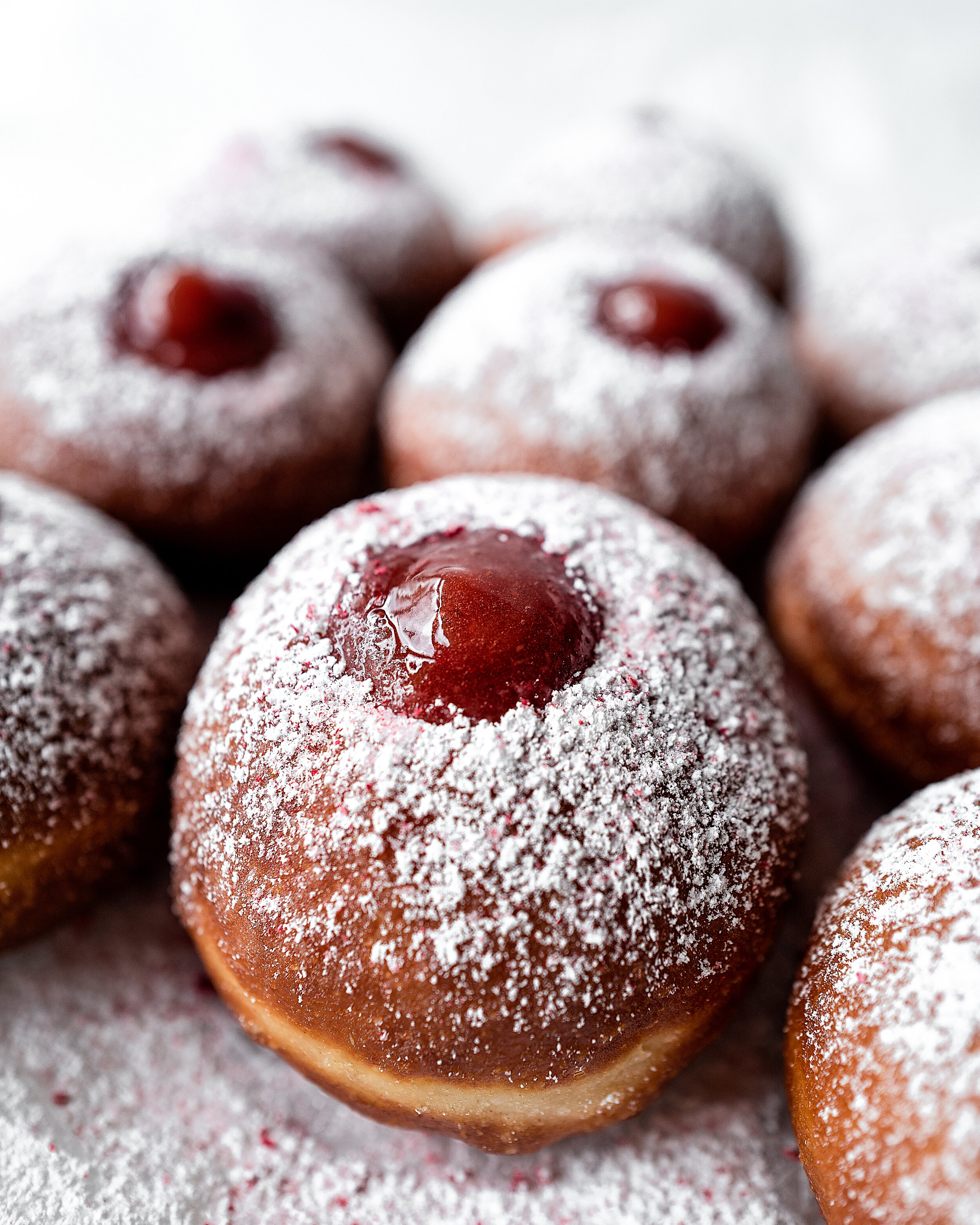uri scheft's sufganiyot
Originally brought to Israel by Polish Jews (who called them ponchik), sufganiyot have been a staple of Hanukkah since the 1920s, when the Israeli labor federation championed these jam-filled donuts as a holiday treat in an effort to create more jobs for more people. (This is according to Gil Marks’ Encyclopedia of Jewish Food. I don't just know this.) In Israel today, the ubiquitous sufganiyah is synonymous with Hanukkah and a thriving industry for the country. It's also become popular in the States.
This particular sufganiyah recipe comes from Uri Scheft of New York City’s Breads Bakery and Tel Aviv’s Lehamim Bakery; both bakeries have an outrageous demand for sufganiyot come Hanukkah. There's no technical difference between a sufganiyah and any other jelly donut, except in name. And while I tend to prefer a brioche-based donut, this version from Uri is lovely. It’s lighter than brioche, with less butter and eggs, and the dough is flavored with orange juice and zest and brandy. Of course, you could fill it with whatever you want—the modern sufganiyah comes in many forms—but a good strawberry jam works particularly well with this boozy, citrusy dough.
Uri Scheft’s Sufganiyot
Slightly adapted from Breaking Breads: A New World of Israeli Baking by Uri Scheft and an earlier version of the recipe which appeared in Bon Appétit.
Makes about 16.
I’ve merged the methods from both sources above for clarity and substance and added some small tweaks of my own. Uri calls for a high-protein all-purpose flour (11.7%; i.e. King Arthur) for best gluten development. I’ve adjusted the original flour weight measurement from 4 cups=500g to 4 cups=480g both because it aligns with the King Arthur measurement and to allow for some wiggle room to add more flour as needed. (And fear not, a moderate-protein flour, like Gold Medal, will work just fine.) You can also probably do either the first rise or the second rise overnight in the refrigerator, but I have not done so yet with this particular recipe.
INGREDIENTS
2 1/4 teaspoons active dry yeast
4 cups (480g) all-purpose flour, sifted, plus more for dusting
1 tablespoon + 1/4 cup sugar
2 large egg yolks
1 large egg
1/2 cup warm whole milk
1/2 teaspoon finely grated orange zest
2 tablespoons fresh orange juice
1 tablespoon brandy (optional)
1 teaspoon kosher salt
1/2 teaspoon vanilla extract
6 tablespoons (3/4 stick) unsalted butter, room temperature, cut into pieces, plus more
Vegetable oil for frying (about 8 cups)
1 1/2 cups strawberry jam
Confectioners’ sugar for dusting
METHOD
MAKE THE DOUGH + FIRST RISE:
Combine yeast, 2 tablespoon warm water, 1 tablespoon flour, and 1 tablespoon sugar in the bowl of a stand mixer; let stand until yeast starts to bubble, about 5-10 minutes.
Whisk in egg yolks, whole egg, milk, orange zest, orange juice, brandy (if using), salt, vanilla, sifted flour, and remaining 1/4 cup sugar. Mix on low speed with dough hook until combined, about 2 minutes.
Turn the mixer on medium speed and add the 6 tablespoons butter, one piece at a time, mixing well between additions. Continue to mix for another 4 minutes, until the dough is soft, smooth, and shiny—the dough will pull away from the the sides of the bowl and climb up the dough hook (add a few tablespoons of flour if needed).
Turn dough out onto a floured work surface and knead, adding more flour as needed, until no longer sticky, about 3-5 minutes. Transfer to a buttered bowl and cover the bowl with plastic wrap. Let rise in a warm, draft-free place until doubled in size, about 1 hour.
CUT THE DOUGH + SECOND RISE:
Roll out dough on a lightly floured surface until 3/4" thick. Use a floured 2 1/2-inch round cookie or biscuit cutter to cut out rounds of dough, twisting to release the dough (this strengthens the edges so the dough puffs when frying). No need to re-roll scraps unless you wish (re-rolling creates a stiffer dough, so I just break the scraps into irregular shapes and fry them like that, after their second rise).
Transfer rounds of dough (and scraps, if using) to a buttered parchment-lined baking sheet and cover loosely with plastic wrap or a kitchen towel. Let rise until not quite doubled in size, 40–50 minutes.
If you are not ready to fry dough, refrigerate rounds up to 3 hours.
FRY + FINISH:
Fit a large heavy saucepan with thermometer; pour in vegetable oil to measure 4" and heat over medium-high heat until thermometer registers 350°F. Use kitchen shears or scissors to cut the parchment paper between the rows and columns of sufganiyot, so that each sufganiyah sits on top of its own parchment square. Working in batches, pick the sufganiyot up by their parchment squares and place them in the oil, frying the dough until golden, about 1 minute per side. (Take care not to crowd the pan because this will lower the oil temperature.) Transfer to a paper towel–lined baking sheet and let cool slightly before filling.
Pulse jam in a food processor until smooth. Scrape jam into piping bag fitted with 1/4" tip (or a ziploc bag with a 1/4'“ opening cut diagonally from one corner). Insert tip into top of sufganiyah and gently fill until jam pokes out of hole (don’t skimp on the jam!). Dust with powdered sugar just before serving.

